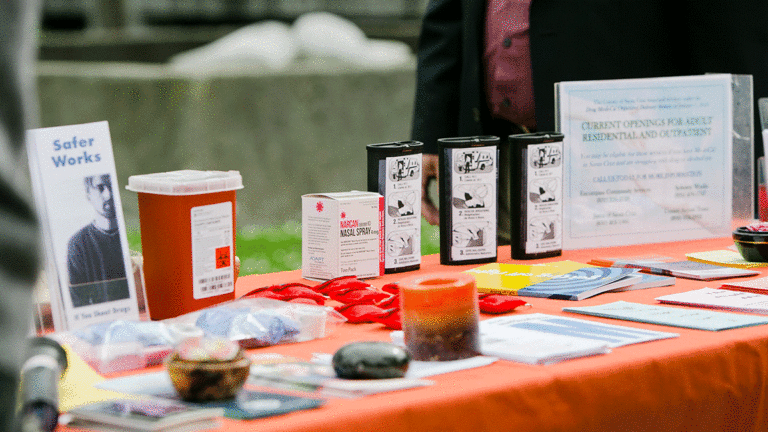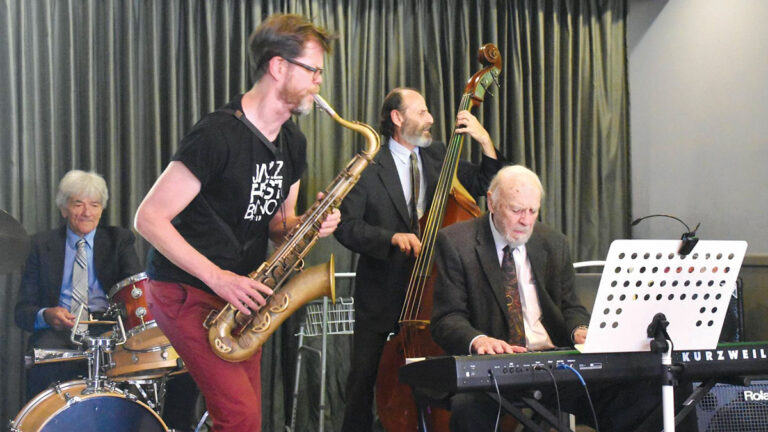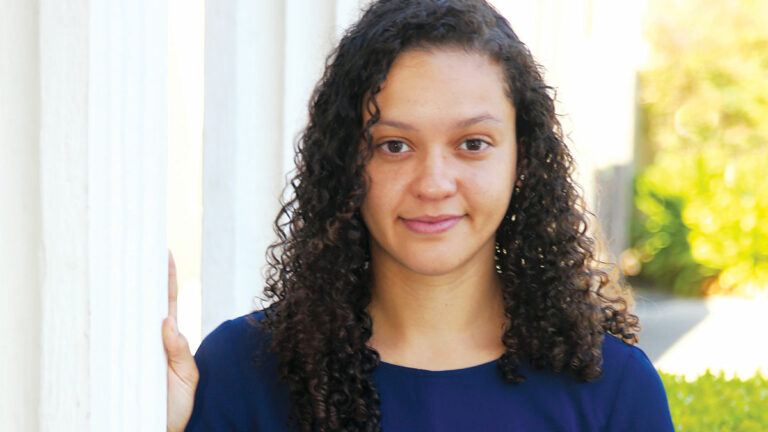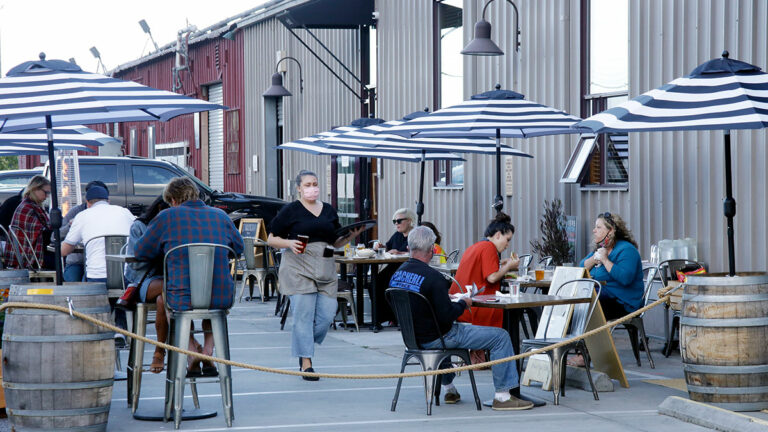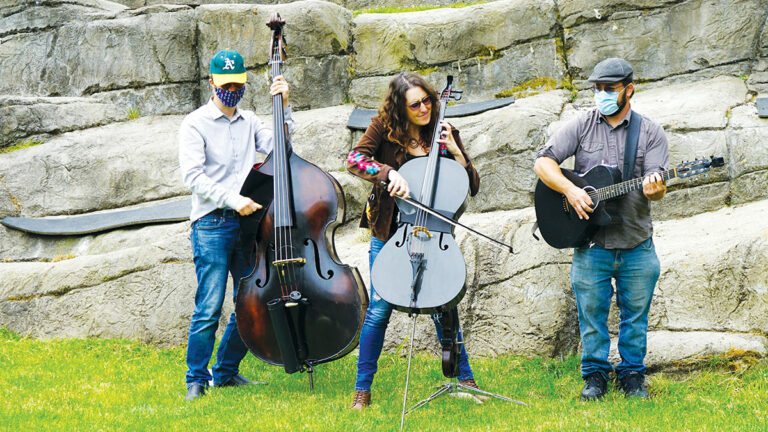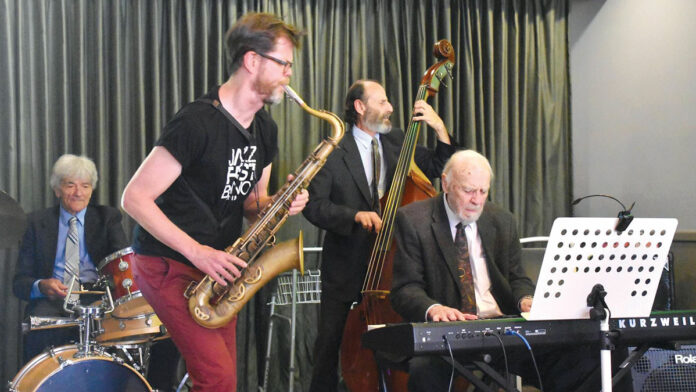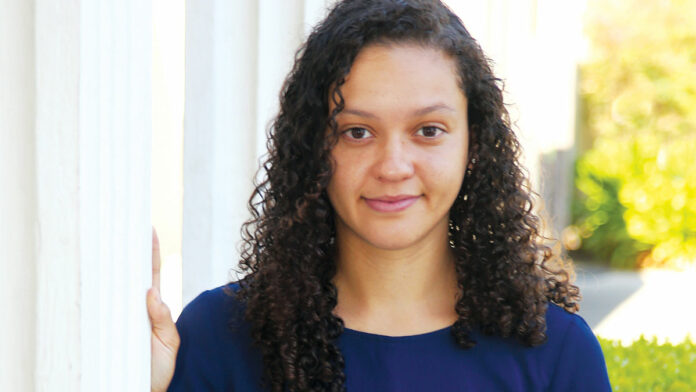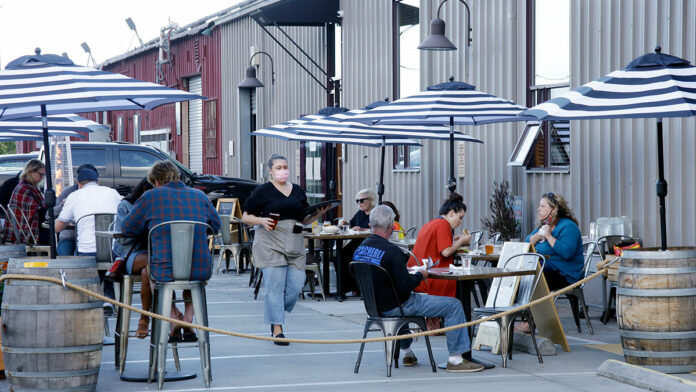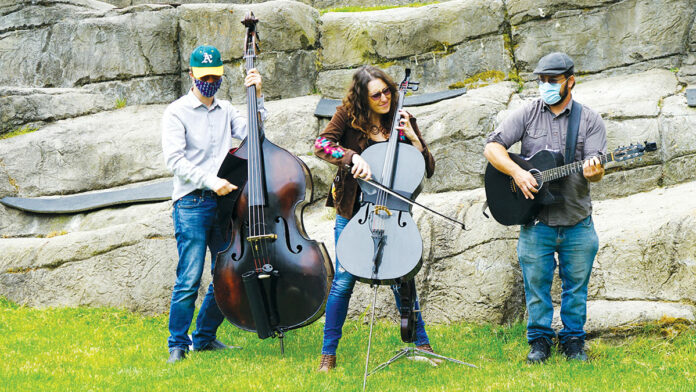To understand Don McCaslin’s amazing dedication to—and love for—jazz, it may be illuminating to start with a little math.
McCaslin—who died July 16 at home in Capitola, at the age of 93—had a famously workman-like attitude when it came to performing. During his heyday in the 1970s and ’80s, the man put in his hours. While some of his contemporaries would play short shows and then retreat into cocktail hour, McCaslin would lead his band for three or four hours—and then, after a break, jump into another long set. Often, he would put together two solid sets during the day in the open-air stage of the Cooper House in downtown Santa Cruz, then trundle off to another club for a dance shift that lasted deep into the night.
He kept this schedule—play jazz, eat, sleep, repeat—for four, sometimes five days a week at one venue, three or four nights a week in another. One member of McCaslin’s group from the old days says the band sometimes played 13 gigs a week.
Long days and full weeks eventually unfolded into years-long, often overlapping residencies in rooms all around Santa Cruz County: 17 years at the Cooper House before it was destroyed by the Loma Prieta earthquake, almost 20 years at the Wharf House in Capitola, and nearly 25 at Severino’s in Aptos, with similarly long runs at the 2525 Club in Soquel, the old Bayview Hotel in Aptos, and the New Riverside in Capitola—not to mention regular slots at the Crow’s Nest, the Balzac Bistro, and many other clubs well-remembered or long-forgotten.
Even though five-days-a-week eventually tapered off into a weekly gig, the veteran vibraphonist and pianist continued to perform regularly deep into old age, long after many players had given up the stage for good. McCaslin’s final show was his regular Thursday night gig at Severino’s in March of 2020, a few months after his 93rd birthday. If not for a certain global pandemic, he might have played there even longer.
Brad Hecht, one of McCaslin’s many long-time bandmates, marveled at his bandleader’s dogged determination to play. “What stopped Don at the Cooper House? The earthquake,” says Hecht. “What stopped Don at Severino’s? The coronavirus. It took an act of god to get this man off the stage.”
Add up all those hours, stack them up into weeks, stretch them over years and decades, and what’s left is a staggering commitment to performance, a (very) rough but conservative estimate of around 35,000 hours on stage. Somewhere, in some point in history, there was probably someone who logged more hours playing live in front of an audience over the course of a single human lifespan than Don McCaslin.
Then again, maybe not. The Guinness Book of World Records is silent on the matter.
The Warmth of Cooper House
Of all the hours Don McCaslin spent on stage, the most golden were those at the Cooper House, the massive brick edifice that was the architectural symbol of downtown Santa Cruz. McCaslin first congregated his jazz band Warmth at the Cooper House’s outdoor stage adjacent to the old Pacific Garden Mall in 1972, and the band quickly became the main attraction in the carnival-like atmosphere of downtown.
Typically, Warmth performed every afternoon, Wednesdays through Sundays, setting the tone and establishing the rhythm of an improbably rich street culture, featuring a list of street performers that now reads like a poignant incantation of a lost Santa Cruz: Artis the Spoonman, Tom “The Bubble Guy” Noddy, the Flying Karamazov Brothers, Ginger the Rainbow Lady, and others.
Steve Wilson arrived in Santa Cruz as a 19-year-old aspiring horn player and was bedazzled by the street scene. “I had come from Fresno,” he says, “and I felt like Dorothy in the Emerald City.”
Percussionist Charles Levin came to visit a friend in 1977. “I just remember the atmosphere,” he says of the Cooper House scene. “It was festive. It was offbeat. It was swinging. And I thought, ‘Yeah, I could do this.’” Within a couple of months, he had moved to town.
At the center of the circus was McCaslin—tall, in black-rimmed glasses, wearing a cabbie’s cap and sporting lots of untamed hair, hunched over his vibes at the center of the bandstand. “He was this totally beatnik-looking figure,” says Levin, “almost like something out of a Kerouac novel.”
“Think Gandolf, with glasses,” says Wilson. “On the one hand, if he didn’t have a smile on his face, you might find him a little scary. But as soon as you started talking to him, that all went away. He was really a warm, sweet man.”
McCaslin had come from San Jose, growing up amid the prune orchards of the pre-Silicon Valley South Bay. He matured into a standout basketball player at San Jose State and worked as an English teacher for more than a dozen years before moving to Santa Cruz to devote himself to jazz in his 40s.
At the Cooper House, he presided over a constantly rotating cast of musicians. A core band was often augmented daily by a fluctuating roster of visiting musicians and vocalists, both experienced veterans and ambitious younger players.
In the 1970s, Santa Cruz was emerging as an unlikely seed bed for a rich jazz subculture. Much of that came from the excellent jazz program at Cabrillo College under the direction of Lile Cruse—and later, Ray Brown. In 1975, the Kuumbwa Jazz Center brought a high-end, sophisticated performance venue to town that could rival jazz clubs in San Francisco or Los Angeles. Just as central to the burgeoning jazz subculture was McCaslin’s band, which served as a kind of academy for young players to get a taste of performing for audiences.
“You basically had a revolving workshop for all these young musicians to play with Don,” says Monterey Jazz Festival Artistic Director Tim Jackson, who co-founded Kuumbwa in 1975. “He was kind of the Art Blakey of Santa Cruz in that he had a gig every day and all these cats went through his band.”
“The band was a school, where you learn how to play by just doing it,” says Eliot Kalman, who played piano with Warmth in the Cooper House era. “I would be exhausted after the weekend, but that was the way you got your chops up. That’s how I got my training.”
McCaslin cultivated an informal and generous atmosphere around his band, allowing musicians to show up and jam, and often giving them room to solo. “He didn’t feel like he had to prove he was the best musician on the bandstand,” says Jackson. “He always gave it up to other players in the band—encouraged them, cultivated them, much like Art Blakey did.”
“He was very open to have people soloing,” says horn man Steve Wilson. “As a jazz musician, it’s really important to have the room to play solos. That’s what it’s all about.”
That open-door policy also applied to vocalists. Though McCaslin didn’t sing himself, the songs he loved—generally jazz standards drawn from the Great American Songbook—often featured vocals, and Warmth had an evolving roster of both male and female singers.
It all contributed to a golden period for any young musician aspiring to jazz. “You could study with Ray at Cabrillo, a world-class instructor,” says saxophonist Brad Hecht. “You could go see Dexter Gordon or Elvin Jones or McCoy Tyner at Kuumbwa. Then you could walk right down the street as a beginning player and have a chance to play some music with a real jazz band.”
A Father’s Legacy
If McCaslin’s name is known today in the larger jazz world outside Santa Cruz, it is due mostly to Donny McCaslin, the bandleader’s son and namesake, one of the top saxophonists in jazz as both a solo act and collaborator who vaulted into the mainstream for his work on David Bowie’s landmark 2016 album Blackstar.
Donny experienced the rich Cooper House scene as a child. His parents were divorced, and the boy was living with his mother in Santa Cruz. The older McCaslin would often bring the boy down to the Cooper House and sit him in a chair on stage.
“For me, it was a pretty colorful environment,” says Donny. “It felt like a carnival as a little kid.” Donny was not, at first, captured by the idea of becoming a musician. At the time, he was more interested in sports, and didn’t pick up the sax until he was on the verge of adolescence. He does, however, remember becoming entranced by a sax player in his dad’s band, an energetic and often barefoot free spirit named Wesley Braxton. Donny says he wasn’t aware of it at the time, but now he believes he took up tenor sax because of Braxton’s wild hippie charisma on stage.
“I remember looking into the bell of his saxophone, and there was a little pool of condensation with a cigarette butt floating in it. That’s pretty gross, if you think about it now. But when you’re 10, it’s like ‘Whoa, he’s cool.’”
Around 12, Donny began taking sax lessons from Brad Hecht, who had replaced Braxton in the band. McCaslin encouraged his son, without applying too much pressure. “He would drive over to where my mother lived, up in Happy Valley, and there was this barn past our house. He would haul his Wurlitzer piano up there. And he’d just play the chords while I practiced. We’d do this once a week. And sometimes, if things were going well, we’d play for what seemed like a long time. But conversely, if I was struggling or getting frustrated, I’d just stop after five minutes. He would just pack up his instrument, carry it back down to his car, and drive home. He never gave me a hard time, none of this, ‘I came all this way’ stuff. That wasn’t his style. That was beautiful about his character.”
“There are two things that I never heard from Don,” says his long-time bass player and friend Jamie Brudnick. “He was not a complainer. I never heard one complaint from him. Ever. And he never said anything bad about any other musician. Not one word.”
Brudnick was on his way to a career as a doctor before deciding against it after already attending medical school (“I got off at the last station,” he says). He opted instead for living in a VW bus and performing music on the street with his buddy. Though he vividly remembers the Cooper House scene, he didn’t begin playing in McCaslin’s band until right after the earthquake, when Warmth would set up in the makeshift “food tents” downtown. He was with McCaslin from that point to his last performance at Severino’s.
Brudnick says McCaslin created a jokey mythology about the band—which later became known as the Amazing Jazz Geezers. “On really hot days, he’d say how lucky we were to have practiced in Ethiopia for years. And on cold days, he’d say, ‘All that training in Siberia is now really paying off.’”
McCaslin had a specific musical orientation based on jazz standards and Latin jazz. His biggest influences were Red Garland, who played piano with Miles Davis in the ’50s, and Cal Tjader, the great Bay Area vibes player who created a signature Latin-flavored sound in the ’50s and ’60s. He also loved pianist Bill Evans, and the great composers of the era from Cole Porter to Irving Berlin to Fats Waller. Performing as much as he did, McCaslin came to know the songs in his set list as intimately as a player can know a song.
“He was a great piano player,” says Brudnick. “He just didn’t make mistakes. For years, I would watch as people would come up from the audience to talk to him. And he’d still be playing while he carried on a conversation.”
Despite his dogged work ethic, McCaslin never got rich or famous playing jazz. At various points in his life, he lived in a VW bus and upstairs at the hotel where he played regularly. He would tell his son that a life in jazz was worth the pursuit only if you loved it and weren’t looking for other rewards from it. But later, he was amazed at the career pinnacles Donny had reached.
“He took a lot of pride in what has transpired in my career,” says Donny. “He took a lot of joy in hearing me giving him updates on what I was doing. Especially in his later years, he was more isolated and we’d get on the phone, and I’d give him as many details as I could, and he was just so excited to hear about all of it.”
Tim Jackson says that Don McCaslin’s lasting legacy is embodied in his youngest son. “All you have to do is look at Donny and see what kind of son he raised. There isn’t a musician in the world who doesn’t love Donny McCaslin, both as a person and as a musician. His dad’s humble work ethic made him into a kind of pied piper on the Santa Cruz scene. But Donny had a bigger vision for himself. And it’s lucky for us that he did.”
McCaslin eventually died from congestive heart failure, which became an ordeal in his later years. Hip surgery several years ago also slowed him down quite a bit. In his final years, playing Severino’s even once a week would leave him exhausted for days afterwards. He started confiding to those close to him that he was uncertain he could continue. Still, he lived a solitary life, and his weekly gig connected him to both the music he loved and the social scene he craved.
“I sometimes have reflected that I think he really loved music more than I do,” says Donny. “He had a depth and a real connection to it. He loved the music so much, it was a central part of his identity.”
Donny visited in January and sat in with his father at Severino’s, as he had done many times over the years. “His entire life was oriented around this one night a week. He’d do the gig and the next day, he’d be completely wasted, with this slow recuperation through the week. But he’d work to get the bounce to be ready for the next one.”
UPDATED Aug. 13, 9:30am: This article was updated to correct the spelling of Jamie Brudnick’s name. We regret the error.


